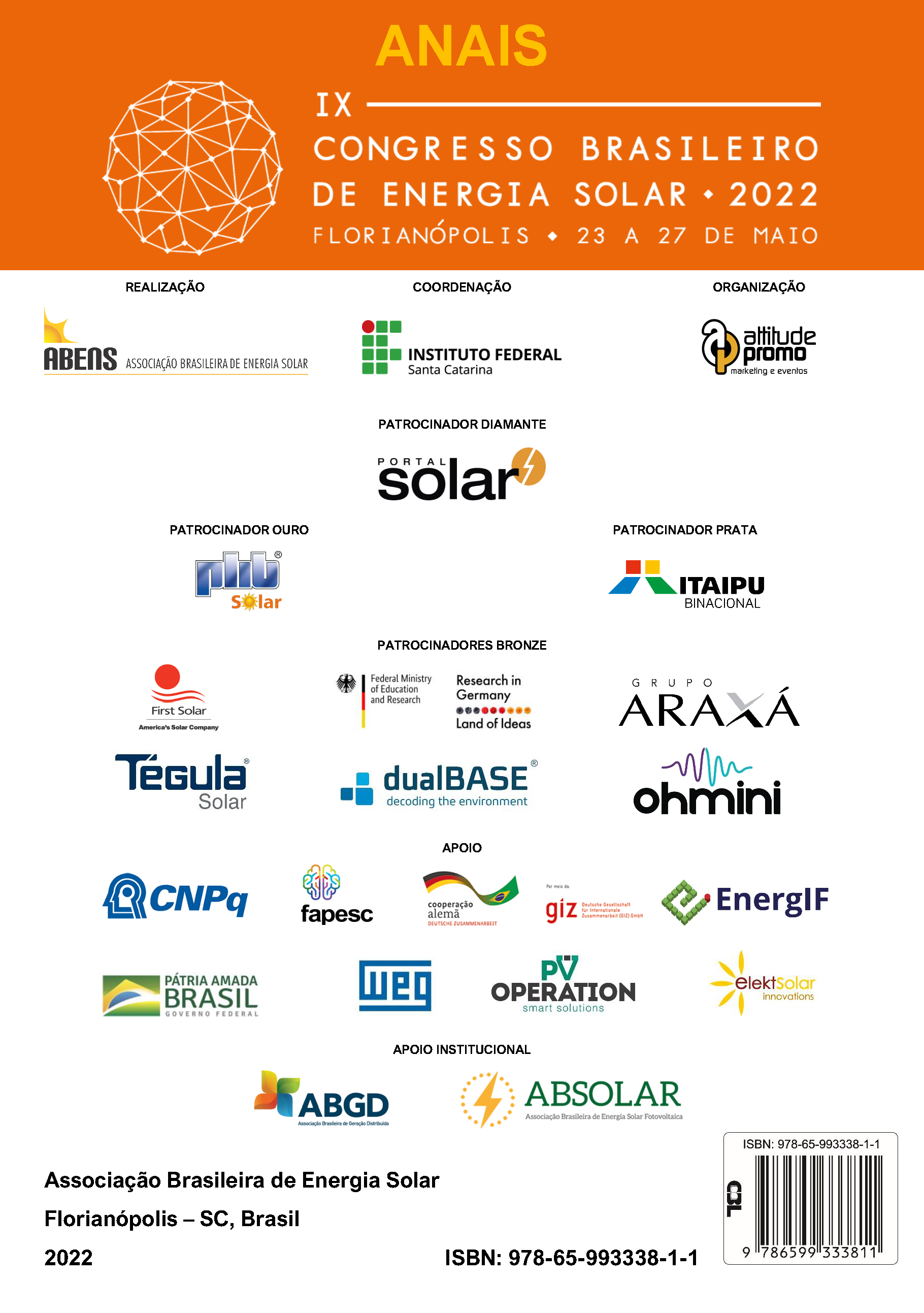1250 PHOTOVOLTAIC SYSTEMS CONNECTED TO THE GRID IN SANTA CATARINA
MONITORED GENERATION VERSUS EXPECTED GENERATION
DOI:
https://doi.org/10.59627/cbens.2022.1206Keywords:
Distributed generation, expected power generation, monitoring of photovoltaic systemsAbstract
A challenge for the growing grid-connected distributed photovoltaic energy market is meeting the generation expectation after the system is installed. The objective of this article is to verify if the estimated energy generation for the first year of operation was achieved in 1250 grid-connected photovoltaic systems installed in the years 2017 and 2018 in the State of Santa Catarina. Each of the analyzed systems has ten 265 Wp photovoltaic modules and a 3 kW inverter. Monthly generation data monitored in the inverter from the first full 12 months of system operation were used to obtain a monthly average for each system and compare with the minimum expectation for the first year. The minimum energy generation expectation for the systems was 249 kWh/month. But only 78% of the monitored systems presented average monthly generation equal to or greater than the expected energy, 13% performed below expectations and 9% of the systems had incomplete monitored data. It is recommended for future studies to verify the possible causes for those 277 systems to be outside the generation expectation or without monitored data.
Downloads
References
Frequência de ocorrência
Geração média mensal monitorada do primeiro ano (kWh/mês)
Antoniolli, A. F. G. C., 2015. Avaliação do desempenho de geradores solares fotovoltaicos conectados à rede elétrica no Brasil, Dissertação de Mestrado, PPGEC, UFSC, Florianópolis.
Baumann, V. A. R., 2018. Viabilidade econômico-financeira de sistemas fotovoltaicos conectados à rede em Florianópolis-SC utilizando dados monitorados e simulados do primeiro ano, Trabalho de conclusão de curso, IFSC, Florianópolis.
Brasil, 2016. Agência Nacional de Energia Elétrica, Micro e minigeração distribuída: sistema de compensação de energia elétrica, Cadernos temáticos ANEEL, ed. 2, Brasília.
Chivelet, N. M.; Solla, I. F., 2010. Técnicas de Vedação Fotovoltaica na Arquitetura, Bookman.
EPE, 2021. Empresa de Pesquisa Energética, Balanço Energético Nacional, Relatório Síntese ano base 2020, Rio de Janeiro.
Medeiros, V., 2022. Mercado de energia solar trará R$51 bi de investimentos ao Brasil e mais de 357 mil novos empregos, afirma Absolar, CPG, Disponível em < https://clickpetroleoegas.com.br/mercado-de-energia-solar-trara-r-51-bi-de-investimentos-ao-brasil-e-mais-de-357-mil-novos-empregos-afirma-absolar/>, Acesso em 13 jan. 2022.
Nakabayashi, R. K., 2015. Microgeração fotovoltaica no Brasil: Condições atuais e perspectivas futuras, Nota técnica Abinee, Disponível em: < http://www.abinee.org.br/informac/arquivos/mifoto.pdf>, Acesso em: 20 ago 2020.
Pinho, J. T.; Galdino, M. A., 2014. Manual de engenharia para sistemas fotovoltaicos, CEPEL, CRESESB, 2014.
Roberts, J. J.; Zevallos, A. A. M.; Cassula, A. M., 2016. Assessment of photovoltaic performance models for system simulation, Renewable and Sustainable Energy Reviews, vol. 72, pp. 1104-1123.
Rüther, R., 2004. Edifícios solares fotovoltaicos. ed. 1, LABSOLAR, UFSC.
Sorgato, M. J.; Rüther, R., 2017. Avaliação da geração fotovoltaica versus consumo de eletricidade de uma residência unifamiliar em diferentes condições climáticas, ENTAC 2017, Balneário Camboriú.
Villalva, M. G.; Gazoli, J. R., 2013. Energia solar fotovoltaica: Conceitos e aplicações, Érica.


